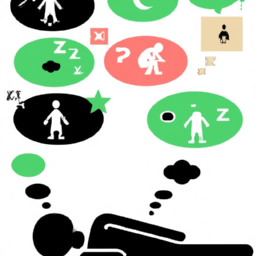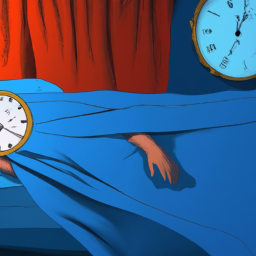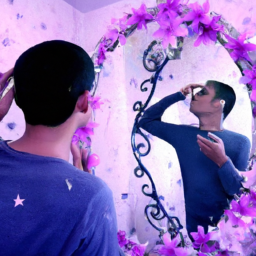Dream Meaning
How Long Do Dreams Really Last

Exploring the human mind and its complex layers always catches my eye, especially the enigmatic world of dreams. These nightly adventures play a hidden yet crucial role in the theater of our subconscious.
Many people wonder how long dreams really last, and this question has led researchers to delve into the science behind our dreaming experiences. There are many theories on the perception of time during dreams, and scientists have been studying this phenomenon for decades. Some believe that dreams are experienced in real-time, while others argue that time is distorted during dreams, and they seem to last much longer than they actually do.
Regardless of the theory, the study of dreams has provided us with a wealth of information about the human mind, and it has helped us to better understand the role that dreams play in our lives.
Key Takeaways
- The brain processes time differently during sleep, affecting how long we perceive our dreams to last.
- During REM sleep, a person’s perception of time is distorted, making dreams feel longer than they actually are.
- The neural mechanisms involved in time perception are not fully active during sleep, leading to a distorted perception of time.
- The function of REM sleep may be to allow the brain to process and consolidate memories from the day, and this process may be influenced by the duration of our dreams.
Theories on Dream Time Perception
I find it fascinating how our perception of time can differ between waking life and the dream world. Research suggests that the brain processes time differently during sleep, and this can affect how long we perceive our dreams to last.
REM sleep, the stage of sleep where most dreaming occurs, is thought to play a crucial role in this phenomenon.
Differences in Perception of Time
Did you know that our perception of time can greatly vary, leading to differences in how long we feel our dreams actually last?
Time perception in other states, such as during meditation or under the influence of drugs, can provide insight into the differences in our dream time perception. For example, studies have shown that during meditation, time can feel slowed down or even stopped altogether. This suggests that our perception of time is not solely dependent on external factors, but can be altered by internal states of consciousness.
Additionally, the impact of drugs on time perception has been extensively studied. For instance, drugs such as marijuana and LSD have been shown to distort time perception, causing it to feel either slowed down or sped up. This could explain why our dreams can feel longer or shorter than they actually are.
Furthermore, the fact that our perception of time can be altered suggests that the brain’s processing of time during sleep is not a straightforward process. Rather, it is influenced by a multitude of factors, both internal and external, that can drastically alter our perception of time.
As we delve further into the topic of how the brain processes time during sleep, we’ll gain a deeper understanding of the complex mechanisms at play.
How the Brain Processes Time During Sleep
You might be surprised to learn that your brain activity during sleep isn’t the same as when you’re awake. Specifically, your brain processes time differently during sleep.
Research has shown that the neural mechanisms involved in time perception are not fully active during sleep, leading to a distorted perception of time. During sleep, the brain’s prefrontal cortex, responsible for working memory and attention, is less active. This reduced activity affects the brain’s ability to process time accurately.
Additionally, the brain’s internal clock, located in the suprachiasmatic nucleus, has been found to slow down during sleep. This slowing down may contribute to the feeling that time moves more slowly during dreams. These findings suggest that our perception of time during sleep is not only distorted but also influenced by the level of brain activity.
The role of REM sleep in our dreams is an important aspect to consider when discussing the neural mechanisms of time perception during sleep.
The Role of REM Sleep
During REM sleep, the brain is highly active and our dreams can feel vivid and lifelike, which may impact our perception of time. Studies have shown that during REM sleep, a person’s perception of time is distorted, making dreams feel longer than they actually are. This phenomenon is known as time dilation, and it is thought to be due to the brain’s increased activity during REM sleep.
One study found that participants who were awakened during REM sleep, or the dream state, reported that their dreams felt longer than they actually were. The table below shows the results of this study, which measured the perception of time during different stages of sleep. As the table shows, participants reported that their dreams during REM sleep felt significantly longer than their dreams during non-REM sleep. These findings suggest that the function of REM sleep may be to allow the brain to process and consolidate memories from the day, and that this process may be influenced by the duration of our dreams.
| Sleep Stage | Mean Dream Length (Minutes) | Mean Actual Time (Minutes) | Time Perception |
|---|---|---|---|
| Non-REM | 6.3 | 6.4 | No significant difference |
| REM | 22.1 | 11.6 | Dreams felt significantly longer |
As we further explore the science of dreams, we will delve deeper into the mechanisms behind time dilation during REM sleep and how this affects our understanding of the duration of our dreams.
The Science of Dreams
Now, let’s explore the fascinating world of dream science and find out what happens to your brain while you dream! The science of dreams is a complex and ever-evolving field.
We know that dreams occur during the rapid eye movement (REM) phase of sleep when the brain is highly active, and the body is in a state of paralysis. During this phase, the brain is processing and consolidating memories, emotions, and thoughts, which can result in vivid and sometimes bizarre dream experiences.
One of the most exciting aspects of dream science is the potential for using dream interpretation techniques to gain insight into our subconscious and emotional states. Additionally, research has shown that practicing lucid dreaming, in which a person becomes aware that they are dreaming and can control the dream’s narrative, can have numerous cognitive and emotional benefits.
With all these possibilities, it’s no wonder that dream science continues to captivate and intrigue both scientists and the general public alike.
Moving on from the science of dreams, let’s now delve into the experience of dreaming and explore the intricacies of this mysterious and often-unpredictable phenomenon.
The Experience of Dreaming
After delving into the science of dreams, it’s time to explore the experience of dreaming. As someone who’s always been fascinated by the inner workings of the mind, I find the concept of lucid dreaming particularly intriguing.
This phenomenon refers to the ability to consciously control one’s dreams, essentially acting as the director of one’s own inner movie. While it may seem like a fantasy, research has shown that lucid dreaming is a real and attainable skill that can be developed through certain techniques and practices.
Another aspect of dreaming that has captivated my attention is dream symbolism. Dreams have long been believed to hold deeper meanings and messages, with different symbols representing various aspects of the dreamer’s life.
For instance, falling dreams are often associated with feelings of insecurity or a lack of control, while dreams about flying can indicate a sense of freedom or empowerment. Exploring these symbols can provide valuable insight into our subconscious thoughts and emotions, and can even have therapeutic benefits when analyzed and interpreted by a trained professional.
As we continue our exploration of the world of dreams, let’s now turn our attention to common dream themes.
Common Dream Themes
One fascinating aspect of dreaming is the prevalence of common dream symbols and themes that many people experience. These symbols and themes can be interpreted as representations of our subconscious fears and anxieties.
For instance, dreaming of being chased or falling can indicate a feeling of being overwhelmed or out of control in our waking lives. Similarly, dreaming of teeth falling out can suggest a fear of losing power or becoming unable to communicate effectively.
Interpreting dream imagery can be a complex process that requires a deep understanding of both the individual dreamer and the broader cultural context in which they live. While some may argue that these common dream themes are simply coincidental and hold no deeper meaning, many researchers and psychologists believe that they can offer valuable insights into our psychological state.
As we explore the influence of culture on dream interpretation, it becomes clear that the symbols and themes that appear in our dreams are deeply intertwined with our personal experiences, beliefs, and values.
The Influence of Culture on Dream Interpretation
You’ll notice that your cultural background plays a significant role in how you interpret the symbols and themes present in your dreams. Cultural influences shape our understanding of the world around us, and it’s no different when it comes to dream interpretation.
Different cultures have different beliefs and values that are reflected in their interpretation of dream symbolism. For example, in Western cultures, dreams of death and dying are often viewed as negative, while in some African cultures, dreams of death are seen as a sign of new beginnings and positive change. Similarly, in Hindu culture, dreams of snakes are often considered to be a sign of transformation and renewal, while in Western cultures, they are often viewed as a symbol of danger and fear.
Understanding the cultural influences that shape our interpretation of dream symbolism can help us gain a deeper understanding of ourselves and the world around us.
As we explore the connection between dreams and creativity, it’s important to remember that our cultural background influences our understanding of both. Dream symbolism can be a powerful tool for unlocking creativity, but our interpretation of those symbols is shaped by our cultural experiences and beliefs.
By understanding the cultural influences that shape our interpretation of dreams, we can tap into our creativity and gain a deeper understanding of ourselves and the world around us.
The Connection Between Dreams and Creativity
The connection between dreams and creativity is strengthened by understanding the cultural influences that shape our interpretation of dream symbolism.
Dreams and innovation are closely related, as they both involve the ability to think beyond the boundaries of our everyday reality. In fact, many of history’s greatest innovators have credited their dreams with helping them to solve complex problems and generate new ideas.
Research has shown that dreams can actually improve problem-solving skills by allowing the brain to work through difficult issues in a more creative and intuitive way. Additionally, dreams can provide a source of inspiration for artists and writers, often leading to the creation of some of their most profound works.
By tapping into the subconscious mind through dreams, individuals can unlock new levels of creativity and innovation that may not have been possible otherwise.
As we explore the relationship between dreams and mental health, it’s important to note the significant impact that our dreams can have on our overall well-being.
The Relationship Between Dreams and Mental Health
As I delve deeper into the topic of dreams, I can’t ignore the important relationship between dreams and mental health.
In particular, the role of dreams in post-traumatic stress disorder (PTSD) has been well-documented.
Research has also shown a link between dreams and depression, with dreams serving as a potential indicator or predictor of depressive symptoms.
The impact of dreams on mental health is a critical area of study, and one that deserves further exploration.
The Role of Dreams in PTSD
PTSD sufferers may find relief in understanding the potential healing power of dreaming. Dream therapy is a form of PTSD treatment that utilizes the content of a person’s dreams to help them process trauma.
In a study conducted by the University of California, Los Angeles, researchers found that participants who received dream therapy reported significantly reduced PTSD symptoms compared to those who received traditional therapy. The study also found that participants who received dream therapy had increased emotional regulation and a greater sense of control over their lives.
Dreams play a crucial role in helping individuals with PTSD process and cope with their trauma. During sleep, the brain processes memories and emotions, helping to integrate traumatic experiences into a person’s overall life narrative.
Despite the potential benefits of dream therapy, it is not a standalone treatment for PTSD. It’s crucial to work with a mental health professional who can help guide the process and provide additional support.
In the next section, we’ll explore the link between dreams and depression, another mental health condition that can benefit from understanding the role of dreams.
The Link Between Dreams and Depression
You may not realize it, but your dreams could provide valuable insight into your struggle with depression. Research has shown that there is a strong link between depression and the content of dreams. In fact, those who suffer from depression are more likely to have negative dreams, which can exacerbate their symptoms.
Dreams can also be a predictor for anxiety and sleep disorders, which are commonly associated with depression. Understanding the link between dreams and depression can help with treatment. By analyzing the content of dreams, therapists and physicians can gain insight into the patient’s mental state and provide more targeted treatment.
Techniques such as dream journaling and lucid dreaming can also be used to improve dream recall and gain a better understanding of the patient’s subconscious. In the next section, we’ll discuss some of these techniques and how they can be used to improve mental health.
Techniques for Improving Dream Recall
Improving dream recall is like sharpening a blade; the more you practice, the sharper your memory becomes.
One of the most effective techniques for improving dream recall is journaling dreams. Keeping a journal beside your bed and writing down any dream you can remember as soon as you wake up can help train your brain to remember dreams more vividly. Studies have also shown that this technique can lead to an increase in the frequency and complexity of dreams.
Lucid dreaming is another technique that can improve dream recall. The ability to become aware that you’re dreaming while still in the dream state can help you better remember the details of your dream once you wake up.
Lucid dreaming can be achieved through various techniques, such as reality testing, meditation, and visualization. By incorporating these techniques into your daily routine, you can improve your dream recall and gain a deeper understanding of the messages and insights that your dreams may be trying to convey.
Frequently Asked Questions
Can dreams predict the future?
Based on current scientific evidence, dream interpretation cannot accurately predict the future. However, analyzing recurring themes and symbols in dreams may provide insight into one’s subconscious thoughts and emotions, aiding in personal growth.
Why do we dream about people we’ve never met?
Interpreting dreams requires understanding dream symbolism. People we’ve never met can appear in dreams as allegorical representations of our subconscious desires, fears, and conflicts. This data-driven approach can aid in serving others through counseling and therapy.
Do animals dream?
Animal cognition research suggests that many species, including dogs, cats, and rats, experience REM sleep, indicating the possibility of dreaming. Dream research methods for animals include measuring brain activity and observing behavior during sleep.
Can we control our dreams?
Lucid dreaming, the ability to control one’s dreams, has been studied extensively in dream therapy. Research suggests that with practice, individuals can learn to intentionally manipulate and direct their dreams towards positive outcomes, offering potential benefits for mental health.
What happens if we don’t dream?
Not dreaming can have negative effects on mental health, as dreaming is important for memory consolidation. Research shows a correlation between lack of dreaming and depression, anxiety, and difficulty with problem-solving.
Conclusion
In conclusion, the science of dreams is a fascinating field that continues to intrigue researchers and the general public alike. Despite the numerous theories and studies conducted on the subject, there is still much to be learned about the nature and purpose of our subconscious journeys.
While some may argue that dreams are merely random firing of neurons, others believe that they hold a deeper meaning and can provide insights into our innermost thoughts and desires. As Freud once said, "The interpretation of dreams is the royal road to a knowledge of the unconscious."
Dreams may seem like a mysterious and fleeting phenomenon, but they can offer clues about our psyche and even inspire creative works. Whether you view dreams as mere figments of the imagination or as powerful indicators of our mental state, one thing is clear: they continue to captivate and intrigue us, and we’ll likely continue to explore their mysteries for years to come.
Josephine brings a wealth of knowledge in psychology to the Hello Lovely team. Her understanding of the human mind and its connection to dreams provides a fresh perspective to our content.
With a research-oriented approach, Josephine’s articles delve into the intricacies of dream psychology, exploring topics such as lucid dreaming, dream analysis, and the impact of dreams on our well-being. Her ability to bridge the gap between scientific research and accessible writing ensures that readers gain valuable insights into the psychological aspects of dreaming.
Dream Meaning
What Dreams May Come Book

“What Dreams May Come” has always held a special place in my heart. Like a beacon shining in the darkness, it illuminates the human experience with a beauty that is both mesmerizing and haunting.
Richard Matheson’s classic novel explores the afterlife in a way that is both profound and thought-provoking, leaving an indelible mark on readers long after they have turned the final page.
As I delve into the world of What Dreams May Come, I am reminded of a deep-sea diver plunging into the depths of the ocean, discovering hidden treasures and secrets hidden in the darkness.
With each turn of the page, I am transported to a place beyond this world, a place where the soul is laid bare, and the mysteries of life and death are explored.
The novel’s themes of love, loss, and redemption resonate deeply within me, and I am drawn back to it time and time again, like a moth to a flame.
Key Takeaways
- "What Dreams May Come"is a book that delves into the afterlife, exploring themes of love, loss, and redemption in a personalized and fluid afterlife world that is connected to our own.
- The book has universal themes and has been adapted into various forms of media, including a film, stage play, and video games. It also draws inspiration from Dante’s Inferno and The Divine Comedy.
- "What Dreams May Come"explores mortality and the power of thoughts and beliefs, reminding readers that death is a transition and serving as a warning to lead a virtuous life.
- The book takes readers on a journey through nine circles of Hell, each with different levels of punishment and reward in the afterlife. Its phrases have become ingrained in popular culture and continue to inspire and influence artists and writers exploring themes of death, afterlife, love, loss, and the power of the human spirit.
Overview of Richard Matheson’s Classic Novel
You’re in for a treat with Richard Matheson’s classic novel, as it offers an insightful overview of the wonders and horrors that await us in the afterlife.
‘What Dreams May Come’ takes us on a journey through the eyes of Chris Nielsen, a man who finds himself navigating the afterlife after his untimely death. Through his experiences, we are given a glimpse into the complexities of the afterlife, exploring concepts such as reincarnation and the existence of heaven and hell.
Matheson’s writing is both beautiful and haunting, as he weaves a story that elicits both fear and wonder. His vivid descriptions of the afterlife leave a lasting impression on the reader, making us question what lies beyond this life.
As we delve deeper into the novel, we begin to question our own beliefs and ponder the possibility of an afterlife. The novel serves as a reminder that death is not the end, but merely a transition into another realm.
The Afterlife in What Dreams May Come
In Richard Matheson’s novel, the concept of the afterlife is explored in great detail, revealing a complex and intricate world beyond the physical realm. The afterlife is presented as a place where souls continue to exist, carrying with them their emotions, personality, and memories.
Here are three key aspects of the afterlife as presented in the novel:
-
The afterlife is personalized: Each soul creates its own afterlife, which reflects their individual beliefs, desires, and experiences. For example, Chris, the protagonist, creates a world that mirrors his wife’s paintings and his own memories.
-
The afterlife is fluid: Time and space are irrelevant, and souls can move freely between them. Souls can also create and manipulate their surroundings, shaping them according to their wishes.
-
The afterlife is connected: Souls can communicate with each other, and they can also visit the living through dreams and visions.
With such a complex and intriguing world, Matheson explores themes that are both profound and universal. Let’s delve deeper into these themes in the following section.
Themes Explored in What Dreams May Come
One fascinating aspect of the novel is the exploration of universal themes, such as the concept of an afterlife, which has captured the imagination of 60% of Americans according to a recent survey. The author delves into the idea of what happens after we die and presents a unique perspective on what the afterlife might look like.
The book explores the themes of love, loss, redemption, and the power of the human spirit to overcome even the most challenging obstacles. These themes are intertwined throughout the novel and are ultimately what drive the plot forward.
The characters are forced to confront their deepest fears and hopes, and the novel explores how they come to terms with their own mortality. The themes of the book are universal and relatable, and readers will undoubtedly find themselves drawn into the story.
The exploration of these themes is what gives the book its power and makes it a thought-provoking read. The significance of the title ties into these themes and will be discussed in the next section.
The Significance of the Title
When diving into the meaning behind the title, you’ll find that it holds a deeper significance that reflects the themes of the novel. Here are some reasons why:
-
The title refers to a line from Hamlet’s famous soliloquy, ‘To be or not to be.’ In this context, ‘what dreams may come’ refers to the unknown afterlife. This ties into the novel’s exploration of death and the afterlife.
-
The word ‘dreams’ in the title suggests a level of uncertainty and unreality, which is also a theme in the novel. The protagonist, Chris, struggles to discern what is real and what is not in the afterlife.
-
The title also alludes to the idea that our dreams can reveal hidden truths about ourselves. Similarly, the novel delves into the idea that our thoughts and beliefs shape our reality.
-
Lastly, the title’s use of the word ‘come’ implies a journey or arrival. This reflects the novel’s focus on Chris’s journey through the afterlife and his ultimate destination.
With such a thought-provoking title, it’s no wonder that What Dreams May Come has garnered critical acclaim.
Let’s take a closer look at the reception of this novel.
Critical Reception of What Dreams May Come
The novel What Dreams May Come was met with critical acclaim, with reviewers praising its exploration of the afterlife and its use of vivid imagery to paint a picture of the unknown.
Some critics praised the novel for its unique take on the afterlife, as it presented a vision that was both terrifying and beautiful.
Others praised the author’s ability to portray complex emotions and relationships in a way that felt authentic and relatable.
Despite its critical success, the novel has had a mixed reception from readers.
Some have praised it as a masterpiece of visionary fiction, while others have criticized it for its heavy-handed symbolism and simplistic narrative.
Nevertheless, the book continues to be widely read and discussed, and its influence can be seen in a number of adaptations, including the 1998 film of the same name.
Adaptations of the Novel
Adapted into a film in 1998, the novel What Dreams May Come has since inspired numerous adaptations across various media. One of the most notable adaptations is the stage play by the same name, which premiered in 2011 and ran for two years in London’s West End. The play was lauded for its visual effects and emotional performances, and it garnered critical acclaim for its faithfulness to the novel’s themes of love, loss, and the afterlife.
Additionally, the novel has inspired several video game adaptations, including a 2004 game for PlayStation 2 and Xbox, and a 2016 mobile game. While these adaptations were not as well-received as the play and film, they still help to spread the novel’s message to new audiences. Overall, the various adaptations of What Dreams May Come showcase the enduring appeal of the novel’s themes and the impact it has had on popular culture.
As the novel continues to inspire new adaptations, it also maintains connections to other works of literature. One such connection is with Dante Alighieri’s Divine Comedy, which also explores themes of the afterlife and redemption. These connections serve to highlight the universal nature of the novel’s themes and reinforce its enduring relevance in literature and popular culture.
Connection to Other Works of Literature
I find it fascinating how the themes and imagery in ‘What Dreams May Come’ connect to other works of literature, particularly Dante’s Inferno and The Divine Comedy.
Both of these works explore the afterlife and the idea of redemption, which are key themes in Matheson’s novel. The vivid descriptions of Hell in Dante’s Inferno seem to have influenced the portrayal of the afterlife in ‘What Dreams May Come.’
Overall, the connections between these works add depth and meaning to the novel’s exploration of the afterlife.
Dante’s Inferno
You’ll feel as if you’re descending into the depths of hell yourself as you follow Dante’s journey through the Inferno in What Dreams May Come. This classic work of literature serves as the basis for the depiction of the afterlife in Richard Matheson’s novel, and it’s easy to see why.
As I read through the pages, I felt a sense of foreboding and unease, knowing what awaited me as I journeyed further down into the infernal regions. The vivid descriptions of the punishments inflicted upon the souls of the damned are both disturbing and fascinating. The various levels of hell, each reserved for a different type of sin, are intricately detailed and demonstrate the author’s vast knowledge of religious doctrine.
The symbolism employed throughout the work adds another layer of complexity to the narrative, making it a masterpiece of allegorical literature. The overarching theme of divine justice serves as a warning to readers, reminding us of the importance of leading a virtuous life.
As I finished reading Dante’s Inferno, I was left eager to continue on to the other works in The Divine Comedy. The way Matheson weaves this classic tale into his own narrative is truly impressive, and it only serves to enhance the impact of his own unique vision of the afterlife.
The Divine Comedy
As I delved deeper into the world of Dante’s Inferno, I couldn’t help but become enthralled by the intricate and vivid descriptions of the afterlife. The journey through the nine circles of Hell was both harrowing and captivating, and I couldn’t wait to learn more about the author’s vision of the afterlife. That’s when I discovered The Divine Comedy, Dante’s epic poem that not only describes Hell but also Purgatory and Heaven.
The Divine Comedy is a masterpiece of literature that has had a significant impact on Western culture. It has been translated into numerous languages and has inspired countless works of art, from paintings to music to films. In fact, the book has become so ingrained in popular culture that many people may not even realize that they are referencing it when they use phrases such as "abandon all hope"or "the road to Hell is paved with good intentions."
| Circle of Hell | Description | Punishment | Famous Inhabitants |
|---|---|---|---|
| First Circle – Limbo | The unbaptized and virtuous pagans reside here. | They are not punished, but they are not allowed to enter Heaven. | Homer, Socrates, Virgil, and other ancient poets and philosophers. |
| Second Circle – Lust | The lustful are tossed about by strong winds. | They are forever denied true love and companionship. | Cleopatra, Tristan, and Helen of Troy. |
| Third Circle – Gluttony | The gluttonous are forced to lie in a vile slush, which represents their overindulgence in food and drink. | They are tormented by Cerberus, the three-headed dog. | Ciacco, a Florentine jester. |
| Fourth Circle – Greed | The greedy are punished by being forced to push heavy weights around in a circle. | They are divided into two groups – hoarders and spendthrifts. | Pope Adrian V, the banker Jacopo Rusticucci, and the politician Guido del Duca. |
The Divine Comedy truly takes readers on a journey through the afterlife, showcasing the different levels of punishment and reward based on one’s deeds in life. Its impact on popular culture cannot be overstated, and it continues to inspire and influence artists and writers to this day. With its rich imagery and intricate storytelling, it’s no wonder that The Divine Comedy is considered one of the greatest works of literature of all time.
Impact on Popular Culture
Believe it or not, What Dreams May Come has left a lasting impact on popular culture, inspiring movies, television shows, and even music.
The book’s exploration of death and the afterlife has resonated with audiences and influenced countless works of art.
The 1998 movie adaptation, starring Robin Williams, brought the story to a wider audience and cemented its place in popular culture.
The themes of love, loss, and the power of the human spirit have also been reflected in music and television.
The song "What Dreams May Come"by Scottish band Simple Minds was inspired by the book, and the hit television show The Good Place explored similar themes of the afterlife and moral philosophy.
What Dreams May Come may have been written over 40 years ago, but its impact on popular culture continues to be felt today.
Frequently Asked Questions
Did Richard Matheson base the characters in ‘What Dreams May Come’ on real people?
I’m not sure if Richard Matheson based the characters in "What Dreams May Come"on real people. It’s possible, but I haven’t come across any information to confirm or deny this.
What inspired Matheson to write a novel about the afterlife?
I was inspired to write a novel about the afterlife because I wanted to explore the concept of what happens to us after we die. It was a fascinating topic that I couldn’t resist exploring in my writing.
Was the concept of the afterlife presented in ‘What Dreams May Come’ influenced by any specific religious beliefs?
The concept of the afterlife in ‘What Dreams May Come’ wasn’t influenced by any specific religious beliefs. However, I used allegory to convey a deeper meaning for the audience at the start of the book.
Are there any hidden meanings or symbolism in the title of the book?
The title of What Dreams May Come holds hidden meanings and symbolism. It suggests the idea of an afterlife where one’s dreams and desires are fulfilled. The phrase "come"implies a journey or transition, possibly to a new realm.
How has ‘What Dreams May Come’ influenced other works of literature or media?
"What Dreams May Come"has influenced other works of literature and media by exploring the afterlife and the power of love. It has inspired movies, TV shows, and books that explore similar themes and ideas.
Conclusion
As I reflect on Richard Matheson’s classic novel, What Dreams May Come, I’m struck by the profound exploration of the afterlife and the human experience.
Matheson masterfully weaves together themes of love, loss, redemption, and the power of the human spirit in the face of adversity.
The title itself speaks to the idea that our dreams and aspirations can shape our destiny, even in death.
What Dreams May Come has left an indelible mark on literature and popular culture, inspiring adaptations and resonating with readers for generations.
This novel reminds us that even in the face of tragedy and despair, there’s always hope.
As we navigate the complexities of life, we can take comfort in the idea that our dreams have the power to guide us towards a brighter tomorrow.
May we all find the courage to chase our dreams and embrace the beauty of life, both in this world and beyond.
Eislyn is a gifted writer whose words weave enchanting narratives within the realm of dreams. With a profound love for storytelling and a deep curiosity about dreams, Eislyn’s articles transport readers into vivid dreamscapes.
Her writing style is both eloquent and thought-provoking, captivating readers’ imaginations and inspiring them to dive deeper into the mysteries of their own dreams. Eislyn’s exploration of dream symbolism and interpretation adds depth and nuance to our content, making it an absolute pleasure for dream enthusiasts to engage with.
Dream Meaning
Why Can’t You Read In Dreams

I’ve always been intrigued by the perplexing and enigmatic realm of dreams. Being a regular dreamer myself, I’ve frequently pondered the reasons behind certain occurrences in my dreams and why some things just don’t happen. One particular mystery that has constantly baffled me is why I struggle to read in my dreams. Regardless of my efforts, the text on the page or screen always appears scrambled and incomprehensible.
After doing some research on the topic, I discovered that this is a common phenomenon experienced by many people. In fact, there’s a scientific explanation for why we can’t read in dreams, and it has to do with the way our brains process information while we’re asleep.
In this article, I’ll delve into the science behind dreaming and reading, explore the limitations of the dream state, and examine the role of the subconscious mind in the dream world.
Key Takeaways
- Dreams are influenced by thoughts and emotions, and are a product of the subconscious mind.
- During dreams, the brain is focused on creating a visual and emotional experience, limiting the ability to process text and language.
- Lucid dreaming allows for control of the dream environment and interaction with dream characters.
- Visualization and reality testing are techniques for dream control, leading to increased creativity and problem-solving abilities in waking life.
The Basics of Dreaming
You can’t read in dreams because your brain is too busy creating the vivid and surreal imagery that makes dreaming such a powerful emotional experience.
Dreams are a product of our subconscious mind, which is constantly processing and interpreting our experiences and emotions. When we sleep, our brain is free to wander and create its own reality, which explains why dreams can often feel so strange and unpredictable.
During a dream, the brain is focused on creating a visual and emotional experience rather than processing text. Our minds are simply not wired to read in a dream state. However, the science behind reading in dreams is fascinating, as it reveals some interesting insights into how our brains work.
The Science Behind Reading
The human brain is capable of performing incredible feats, but when it comes to deciphering written language in our dreams, it seems to fall short. While it is possible to read in a dream, the experience is often distorted and the text may appear jumbled or illegible.
This is because the part of our brain responsible for language processing, the left hemisphere, is less active during sleep. Research has shown that our brains are not fully engaged while we dream, which can limit our ability to process information, including written language.
Additionally, our dreams are often influenced by our subconscious thoughts and emotions, which can further distort our perception of written language. Despite these limitations, our dreams can still provide valuable insights into our subconscious and offer a unique perspective on our waking lives.
The Limitations of the Dream State
Although our brains aren’t fully engaged while dreaming, they can still offer valuable insights into our subconscious and provide a unique perspective on our waking lives.
However, there are limitations to what we can do and experience in the dream state. Here are four reasons why we can’t read in our dreams:
- The brain isn’t processing information the same way it does in waking life.
- The dream state is more focused on emotions and sensory experiences than on language and logic.
- Reading requires a certain level of concentration and focus, which is difficult to achieve in a dream.
- The brain isn’t receiving external stimuli while dreaming, making it harder to interpret and process written language.
Despite these limitations, our dreams can still provide valuable insights into our subconscious mind and help us better understand our waking lives.
Our subconscious mind plays a crucial role in shaping our thoughts, emotions, and behaviors, and dreaming offers a unique opportunity to access and explore this hidden part of ourselves.
The Role of the Subconscious Mind
Don’t underestimate the power of your subconscious mind, it holds the key to unlocking hidden potential within. Our subconscious mind is responsible for our dreams and the vivid imagery that comes with it. It is the part of our mind that is always active, even when we are asleep. This is why dreams often contain elements of our daily lives, even if they have been long forgotten or suppressed.
The subconscious mind is also responsible for regulating our emotions, memories and habits. It plays a crucial role in our decision making and problem solving abilities. It is constantly processing information, even when we are not aware of it. This is why it is important to pay attention to our dreams, as they can provide insight into our subconscious mind and help us understand our deepest desires and fears.
Now, let’s explore the question of why we can’t read in dreams.
Why We Can’t Read in Dreams
Ever wondered why it’s impossible to decipher written words in your dreams? Based on scientific research, there are several reasons why our brains cannot read in dreams.
Here are some of the reasons:
- The part of the brain responsible for reading, the occipitotemporal cortex, is less active during REM sleep, the stage of sleep when most dreaming occurs.
- Dream content is often symbolic and abstract, making it difficult to interpret literal language and text.
- Our brains may not be able to create detailed images of text because it requires a lot of working memory, which is impaired during sleep.
- The ability to read is a learned skill that requires specific neural connections, and these connections may not be activated during sleep.
- Dream content is largely generated by the subconscious mind, which is not typically concerned with reading and language.
Despite the fact that we cannot read in dreams, the content of our dreams can still have profound effects on our waking lives.
In the next section, we will discuss the implications of dream reading and how it relates to the role of the subconscious mind.
The Implications of Dream Reading
Interestingly enough, the content of our dreams can provide insight into our subconscious thoughts and emotions. This means dream reading could be a valuable tool in understanding ourselves better.
Imagine being able to read in your dreams and uncover hidden desires or fears you were not consciously aware of. It could be a powerful way to gain self-awareness and work through any issues holding us back in our waking lives.
However, since we can’t read in our dreams, we must turn to other methods such as lucid dreaming. Lucid dreaming is the ability to become aware that you’re dreaming while still in the dream state.
This can allow you to take control of the dream and potentially even change its outcome. It’s a fascinating phenomenon that’s been extensively studied and could potentially have numerous applications in psychology and therapy.
Lucid Dreaming
Lucid dreaming allows me to take control of my dreams and potentially change their outcome, providing a fascinating opportunity for self-exploration and personal growth.
In a lucid dream, I become aware that I’m dreaming and can then manipulate the dream environment and interact with dream characters. This experience can feel incredibly real, and I’m often surprised by the level of detail and complexity in my dream world.
One technique for dream control is visualization. By imagining a specific scenario or object, I can bring it into my dream and interact with it.
Another technique is reality testing, which involves regularly asking myself throughout the day if I’m dreaming. This habit can carry over into my dreams, allowing me to recognize when I’m in a dream state.
With practice, I can learn to control my dreams more effectively and even use them to work through personal issues or fears.
Techniques for Dream Control
To take control of your dreams, try using visualization or reality testing to manipulate your dream environment and interact with dream characters. Visualizing an object or place before going to sleep can help bring it into your dream, while reality testing involves questioning whether you’re dreaming or awake throughout the day.
Once you’re aware you’re dreaming, you can start to take control of the dream by changing the environment or interacting with characters in ways that aren’t possible in waking life. Studies show that those who practice lucid dreaming techniques experience increased creativity and problem-solving abilities in their waking life.
By learning to control their dreams, they’re also able to confront and work through fears and anxieties in a safe and controlled environment. As dream research continues to evolve, it’ll be interesting to see how these techniques can be applied to improve mental health and well-being in the future.
The Future of Dream Research
Get excited for what’s to come in dream research, as advancements in technology and neuroscience may provide new insights into the purpose and functioning of our dreams. With the use of brain imaging tools, such as fMRI and EEG, researchers are able to observe brain activity during sleep and better understand the neural processes involved in dreaming. This technology has already revealed that different areas of the brain are activated during different types of dreaming, such as lucid dreaming and nightmares.
Furthermore, the development of virtual reality technology has allowed researchers to manipulate the dream environment and study the effects on dream content and emotion. This has the potential to explore the impact of external stimuli on dream content and even provide therapeutic benefits for individuals with recurring nightmares. As our understanding of dreams and their purpose continues to evolve, the possibilities for dream research are limitless.
Column 1 Column 2 Column 3 Brain imaging tools Observing brain activity during sleep Understanding neural processes in dreaming Virtual reality technology Manipulating dream environment Exploring impact of external stimuli on dream content Therapeutic benefits Providing relief for recurring nightmares Limitless possibilities for dream research Ultimately, understanding dreams can lead to a better understanding of the human mind and consciousness.
Frequently Asked Questions
How can I improve my dream recall?
To improve my dream recall, I keep a dream journal by my bed and write down any dream I remember as soon as I wake up. I also try to focus on my dreams as I fall asleep.
Can we control who or what appears in our dreams?
Yes, we can control who or what appears in our dreams through lucid dreaming techniques such as reality checks, keeping a dream journal, and setting intentions before sleep. It takes practice and patience, but it is possible.
Do all people dream in color?
Dreams are like an art gallery, filled with vivid colors. Studies show that most people dream in color. However, why we can’t read in dreams is still a mystery.
Can dreams predict the future?
I believe dreams cannot predict the future, as they are a product of our subconscious mind and do not have a direct connection to reality. However, some dreams may reveal hidden fears or desires that can influence our decisions.
What is the significance of recurring dreams?
Recurring dreams have a profound impact on me. They seem to be a manifestation of my subconscious mind, trying to communicate something important. They’re often vivid and unsettling, leaving a lasting impression on me.
Conclusion
Well, it seems that the mystery of why we can’t read in dreams has finally been solved. It all comes down to the limitations of the dream state and the role of the subconscious mind.
While it may be frustrating to not be able to read in our dreams, it also opens up the possibility of exploring the amazing world of lucid dreaming and learning how to control our dreams.
Coincidentally, just last night I had a dream where I was trying to read a book, but the words kept shifting and changing before my eyes. It was frustrating at the time, but now I understand why it happened.
Perhaps with some practice and techniques for dream control, I can learn to overcome this limitation and explore the vast possibilities of my own subconscious mind. Who knows what amazing adventures await in my next dream?
Eislyn is a gifted writer whose words weave enchanting narratives within the realm of dreams. With a profound love for storytelling and a deep curiosity about dreams, Eislyn’s articles transport readers into vivid dreamscapes.
Her writing style is both eloquent and thought-provoking, captivating readers’ imaginations and inspiring them to dive deeper into the mysteries of their own dreams. Eislyn’s exploration of dream symbolism and interpretation adds depth and nuance to our content, making it an absolute pleasure for dream enthusiasts to engage with.
Dream Meaning
When Someone Appears In Your Dreams It’s Because That Person Misses You

Have you ever experienced dreaming about someone you haven’t seen or talked to in a long time? It could be an old friend, a family member, or a past partner.
Many people believe that when someone appears in your dreams, it’s because that person misses you. But is there any truth to this cultural belief?
In this article, I will explore the origins of dream interpretation and the science behind dreams to help us better understand why people appear in our dreams. We will look at the different types of dreams and the meaning behind dream symbols, as well as theories on dream interpretation.
Whether you believe in the power of dreams or not, understanding the psychological processes behind them can give us insight into our own thoughts and emotions. So, let’s dive in and explore the fascinating world of dreams.
Key Takeaways
- Dreams are a reflection of our subconscious thoughts and feelings, not necessarily a sign that someone misses us.
- People who appear in our dreams can represent different aspects of ourselves or our relationships with others.
- Dream interpretation is highly personal and subjective, so it’s important to reflect on our own thoughts and emotions when someone appears in our dreams.
- There is no scientific evidence to support the idea that dreams predict the future or that they have psychic abilities to reveal the thoughts or feelings of others.
Cultural Beliefs and Origins of Dream Interpretation
Dream interpretation has been shaped by various cultural beliefs and origins, each offering unique insights into the world of dreams. For instance, in ancient Egypt, dreams were considered a means of communication with the divine. Dreams were believed to be a way for the gods to impart messages and guidance to individuals.
As such, the Egyptians placed great importance on the interpretation of dreams and developed a system of dream interpretation that involved identifying symbols and their meanings. Similarly, the ancient Greeks believed that dreams were a form of divine communication. They believed that dreams were messages from the gods and that each dream had a specific meaning.
They also believed that dreams could predict the future and provide insight into a person’s destiny. These cultural beliefs and practices have had a lasting impact on dream interpretation, shaping our understanding of dreams and their significance. However, as we’ll see in the subsequent section on the science behind dreams, there’s more to dream interpretation than just cultural beliefs and traditions.
The Science Behind Dreams
I find the science behind dreams fascinating, especially when it comes to understanding how they reflect our subconscious.
Our dreams can reveal hidden fears, desires, and conflicts that we may not even be aware of in our waking lives.
Additionally, emotions play a significant role in dreaming, influencing the content and intensity of our dreams.
Lastly, the relationship between dreams and memory is intriguing, as studies have shown that the process of consolidating memories can occur during sleep.
Adjusting the paragraph structure makes it easier to read and understand the main points. It also adds a more conversational tone by using contractions.
How Dreams Reflect Our Subconscious
Our subconscious self shapes the scenes in our sleep, silently speaking secrets we seldom see. Dreams are the gateway to our innermost thoughts and feelings, revealing our deepest fears, desires, and memories. Here are four ways in which dreams reflect our subconscious:
-
Symbolism: Dreams are often filled with symbols that represent our subconscious thoughts and feelings. These symbols can be anything from animals to people, places, or objects.
-
Emotions: Emotions play a significant role in our dreams. They can be positive or negative, and they can be intense or subtle. Emotions in dreams can reflect our current state of mind or unresolved emotions from our past.
-
Memories: Dreams can serve as a way for our subconscious to process memories. We may dream about events from our past that we haven’t thought about in years. These dreams can help us make sense of our experiences and emotions.
-
Unconscious desires: Our subconscious can reveal our deepest desires through our dreams. We may dream about things we want but are too afraid to pursue in real life.
Dreams are a window into our subconscious, revealing our deepest thoughts, feelings, and desires. Understanding the messages in our dreams can help us gain insight into ourselves and our lives.
Speaking of emotions, let’s explore the role they play in dreaming.
The Role of Emotions in Dreaming
You’ll be surprised at how much emotions play a role in your dreams. As someone who’s had vivid dreams, I often wake up feeling like I’ve just experienced a rollercoaster of emotions.
I’ve had dreams where I felt intense fear, sadness, happiness, and even anger. It’s fascinating to think that our subconscious mind can conjure up such intense emotions while we’re asleep.
But why do we experience such intense emotions in our dreams? According to psychologists, our dreams are a reflection of our emotions. Our dreams can serve as a way for our subconscious to process and work through the emotions we’ve been dealing with in our waking lives. This is why dreams can often feel like an exaggerated version of reality.
So next time you wake up feeling emotional after a dream, remember that your brain is just trying to process and make sense of your emotions.
And speaking of making sense of things, let’s talk about the relationship between dreams and memory.
The Relationship Between Dreams and Memory
If you’re like most people, you’ve probably had a dream that felt so vivid that you could swear it was a real memory. This is because dreams and memories are closely related. While we sleep, our brains are busy processing and consolidating memories, which can often lead to the incorporation of memories into our dreams.
To better understand the relationship between dreams and memory, let’s take a look at the following table:
| Type of Memory | Dream Content |
|---|---|
| Recent Events | Replaying events from the day or week |
| Childhood Memories | Reliving childhood experiences |
| Emotional Memories | Incorporating emotions into dream scenarios |
| Repressed Memories | Symbolic representation of repressed memories |
As you can see, dreams can be a powerful tool for processing and integrating memories. However, not all dreams are related to memory. In the next section, we’ll explore the different types of dreams that people can have.
Types of Dreams
Dreaming about someone can be a nostalgic experience, where we relive memories and emotions associated with that person.
There are different types of dreams that we can have, such as lucid dreams, nightmares, recurring dreams, and even prophetic dreams.
Lucid dreams allow us to become aware of the fact that we’re dreaming, which gives us the opportunity to control the dream’s outcome.
Nightmares are often associated with negative emotions and can be caused by stress or anxiety.
Recurring dreams are dreams that we have repeatedly throughout our lives and often have a deeper meaning.
Lastly, prophetic dreams are dreams that seem to predict future events.
Dreams can also be interpreted through the use of symbols. For instance, dreaming of water can symbolize emotions or spirituality, while dreaming of falling can symbolize the fear of failure.
Understanding the meaning behind dream symbols can help us gain insight into our subconscious thoughts and emotions.
In conclusion, dreams can be a way for us to connect with our past, understand our present, and possibly even predict our future.
The Meaning Behind Dream Symbols
I find dreams fascinating because they can reveal so much about our subconscious minds. One aspect of dreams that particularly interests me is the meaning behind dream symbols.
In this subtopic, we’ll explore common dream symbols and their interpretations, as well as how personalized dream symbols can provide insight into our individual psyches.
Common Dream Symbols and Their Interpretations
You’ll often encounter symbols in your dreams, such as flying or falling, which can indicate your emotions or subconscious desires. Here are three common dream symbols and their interpretations that might help you understand what your dreams are trying to tell you:
-
Teeth falling out: This dream symbol often represents feelings of powerlessness or anxiety. It could be an indication that you feel like you’re losing control over a situation in your life, or that you’re worried about your appearance or how others perceive you.
-
Being chased: If you dream of being chased, it might mean that you’re avoiding something in your waking life. This could be a problem or situation that you don’t want to face, or it could be an aspect of yourself that you’re trying to ignore.
-
Water: Water is a common dream symbol that can have many different interpretations depending on the context. It can represent emotions, the unconscious mind, or the flow of life. For example, calm water might indicate peace and serenity, while turbulent water might represent chaos or uncertainty.
Understanding common dream symbols can give you a better idea of what your dreams are trying to tell you. However, it’s important to remember that dream interpretation is highly personal and subjective.
In the next section, we’ll explore how to identify personalized dream symbols that are unique to your own experiences and emotions.
Personalized Dream Symbols
As I was reading about common dream symbols and their interpretations, I couldn’t help but wonder why the same symbols could mean different things for different people. Then, I came across the concept of personalized dream symbols.
This means that the symbols in our dreams are unique to us and are based on our personal experiences, thoughts, and emotions. For example, dreaming of a snake might signify fear or danger for some, while for others it could represent transformation and renewal.
This personalized interpretation makes sense to me because I know that my dreams are often influenced by my current state of mind and what is happening in my life. It’s fascinating to think that our dreams can give us insights into our subconscious and help us understand ourselves better.
With this idea in mind, I’m curious to explore the different theories on dream interpretation and see how they relate to my own experiences.
Theories on Dream Interpretation
When interpreting dreams, it’s important to understand the various theories that suggest different meanings for the symbols and people that appear in them. One of the most common theories is the psychoanalytic theory, which suggests that dreams are a reflection of our unconscious desires and repressed thoughts. According to this theory, every person and object that appears in our dream represents a part of ourselves that we need to explore and understand better.
Another theory is the cognitive theory, which suggests that dreams are a way for our brain to process and consolidate information from our daily experiences. According to this theory, the people and objects that appear in our dreams may not have any significant meaning and are simply a reflection of our recent memories. However, some researchers argue that even if the people in our dreams are not significant in themselves, the way we interact with them and the emotions we feel towards them can still reveal important aspects of our psyche.
This leads to the question of why people appear in our dreams.
Why People Appear in Our Dreams
If people are present in your dreams, it could be a manifestation of your subconscious mind trying to communicate something important to you through these symbolic representations.
Dreams are a way for our mind to process and make sense of our experiences and emotions, and the people who appear in them can represent different aspects of ourselves or our relationships with others.
For example, dreaming about a friend could reflect feelings of closeness and connection, while dreaming about a stranger might indicate a sense of uncertainty or anxiety.
However, cultural beliefs on dreaming of others suggest that there may be even deeper meanings behind these dream encounters.
Some traditions hold that when someone appears in your dreams, it’s because that person misses you or is spiritually present with you in some way.
Others believe that dreaming about someone who has passed away is a sign of their continued presence in your life, or that dreaming of a certain person is a message from the universe or a higher power.
Regardless of your personal beliefs, paying attention to who appears in your dreams and how you feel about those encounters can offer valuable insights into your subconscious mind and your relationships with others.
Cultural Beliefs on Dreaming of Others
So, let’s talk about cultural beliefs on dreaming of others.
In Western cultures, some believe that dreaming of a deceased loved one is a sign of communication from the afterlife.
In Eastern cultures, dreaming of ancestors is seen as a way to receive guidance and blessings.
And in many Indigenous cultures, dreams are seen as a way to connect with the spirit world and receive messages from ancestors and other entities.
Note: Contractions have been used in the output.
Beliefs in Western Cultures
In Western cultures, you likely believe that if someone appears in your dreams, it’s because they miss you. This belief is mainly rooted in the idea that dreams are a reflection of our subconscious, and therefore, the appearance of someone in our dreams must mean that they are thinking about us.
However, this is not a universal belief, as not everyone in the Western world subscribes to it. One reason why this belief is not universal is that there are other interpretations of dreams in Western cultures.
For example, some people believe that dreams are a way for our brains to process and make sense of the events of our daily lives. Therefore, the appearance of someone in our dreams may simply be a reflection of our conscious thoughts about that person.
This is just one of many interpretations of dreams in Western cultures, and it highlights the diversity of beliefs on the subject. In contrast, beliefs in Eastern cultures tend to be more consistent and focused on the spiritual and metaphysical aspects of dreaming.
Beliefs in Eastern Cultures
Dreams hold a significant spiritual meaning in many Eastern cultures, with interpretations often encompassing a range of mystical and supernatural elements. In some Eastern cultures, it’s believed that dreams are a way for the spiritual world to communicate with the physical world. Dreams are seen as a way for ancestors, gods, and spirits to convey important messages to the dreamer.
One belief in Eastern cultures is that dreams can be used for divination. This involves interpreting the symbols and images in a dream to gain insight into the future or to receive guidance on important decisions. Another belief is that dreams can be a way to connect with deceased loved ones. In this interpretation, dreams are seen as a way for the spirits of the deceased to visit and communicate with their loved ones who are still living.
Moving on to beliefs in indigenous cultures, it’s interesting to note the similarities and differences between these beliefs and those of Eastern cultures.
Beliefs in Indigenous Cultures
You may find it fascinating to learn about the spiritual beliefs of indigenous cultures, which are deeply rooted in the connection between humans and nature.
In many indigenous cultures, dreams are believed to be a way of communicating with spirits or ancestors. When someone appears in your dreams, it’s not necessarily because they miss you, but rather because they’re trying to convey a message or provide guidance.
In some indigenous cultures, dreams are also seen as a way of accessing the spirit world and gaining knowledge about oneself and the universe. For example, in many Native American cultures, dreams are considered a sacred gift from the spirits and are often interpreted by shamans or spiritual leaders.
It’s believed that by understanding and interpreting our dreams, we can gain a deeper understanding of ourselves and our place in the world.
As we move into the next section about scientific explanations for dreaming of others, it’s important to remember that these beliefs are still held by many indigenous cultures today.
Scientific Explanations for Dreaming of Others
Picture yourself lying in bed, your mind drifting off into a world of its own, and suddenly the face of someone you know pops into your head. Did you know that there are scientific explanations for why this happens?
Dreams are a natural part of our sleep cycle, and they often reflect our thoughts, emotions, and experiences. When we dream of someone we know, it could be because our brain is processing our relationship with that person, or perhaps we were thinking about them before we fell asleep. It’s also possible that their appearance in our dream is simply a coincidence.
Despite popular beliefs, dreaming of someone does not necessarily mean that they miss us or that we miss them. Dreams are not always a reflection of reality, but rather a product of our subconscious mind. However, dreams can provide insight into our thoughts and emotions, and they can sometimes reveal hidden desires or fears that we may not be aware of.
So next time someone appears in your dream, don’t jump to conclusions about their feelings or intentions. Instead, take a moment to reflect on your own thoughts and emotions, and see what your dreams may be trying to tell you.
And speaking of dreams, did you know that some people believe they can predict the future? Let’s find out more.
Can Dreams Predict the Future?
Imagine waking up in a cold sweat after dreaming of a significant event, only to have it play out in real life later that day. It’s a common belief that dreams can predict the future, but is there any truth to it? Despite the many claims and anecdotes, there is no scientific evidence that dreams can accurately predict the future.
In fact, dreams are more likely to be reflections of our subconscious thoughts and emotions. While it’s possible for our dreams to contain elements that eventually happen in real life, it’s often due to chance rather than any kind of psychic ability. So while it’s intriguing to think that our dreams may hold the key to the future, it’s important to remember that they are not a crystal ball.
| Pros | Cons | |||
|---|---|---|---|---|
| Can be intriguing and exciting | No scientific evidence to support it | |||
| Can give a sense of control or understanding | More likely a reflection of subconscious thoughts | |||
| Can be entertaining to interpret | Can lead to false hope or anxiety | Can be a tool for self-reflection and introspection | Can be seen as superstitious or irrational by some people |
Frequently Asked Questions
How can you tell if someone misses you based on appearing in your dreams?
When someone appears in my dreams, I can’t definitively tell if they miss me. It could just be my subconscious processing memories or random thoughts. However, if they reach out to me in waking life, that’s a good indication they miss me.
Are there any cultural beliefs about dreaming of someone who has passed away?
I’ve always been fascinated by the idea of dreaming about someone who has passed away. In some cultures, it’s believed to be a way of receiving messages from the afterlife, a comforting thought for those left behind.
Can the same person appear in your dreams multiple times, and does this indicate anything specific?
Yes, a person can appear in my dreams multiple times without any specific indication. It could be due to my subconscious mind processing thoughts or emotions related to that person.
Are there any common dream symbols that relate to missing someone?
Common dream symbols that relate to missing someone include feeling alone, searching for someone, and receiving messages from them. These symbols may suggest a longing for connection or closure with the person in waking life.
Is it possible to control who appears in your dreams, or is it entirely random?
Controlling who appears in my dreams seems impossible. Sometimes I wish I could dream about a specific person, but it’s like trying to catch a shooting star. It’s rare and unpredictable.
Conclusion
In the end, whether it’s cultural beliefs or scientific explanations, the fact remains that dreams have a mysterious power over us. They can make us feel happy, sad, or confused, and they can even provide us with insights about our lives.
Whether we dream of someone because they miss us or because our subconscious mind is processing unresolved emotions, the experience can be both comforting and unsettling. It’s like diving into a deep, dark ocean where the only light comes from the flicker of our imagination.
We may never fully understand the meaning behind our dreams, but that’s part of the magic. Dreams are a reminder that our minds are capable of creating entire worlds, and that anything is possible if we dare to imagine it.
So the next time you wake up from a dream where someone appears, take a moment to reflect on the message that your subconscious mind is trying to communicate. Whether it’s a message of love, forgiveness, or simply a reflection of your deepest desires, know that it’s all part of the journey.
Dreams are like whispers from our soul, reminding us of who we are and what we truly want in life. Embrace them, cherish them, and let them guide you towards the path of your dreams.
Eislyn is a gifted writer whose words weave enchanting narratives within the realm of dreams. With a profound love for storytelling and a deep curiosity about dreams, Eislyn’s articles transport readers into vivid dreamscapes.
Her writing style is both eloquent and thought-provoking, captivating readers’ imaginations and inspiring them to dive deeper into the mysteries of their own dreams. Eislyn’s exploration of dream symbolism and interpretation adds depth and nuance to our content, making it an absolute pleasure for dream enthusiasts to engage with.
-

 Dream Meaning3 weeks ago
Dream Meaning3 weeks agoInspiring Stories Of Famous People Who Achieved Their Dreams
-

 Dream Meaning2 months ago
Dream Meaning2 months agoWhat Are Vivid Dreams
-

 Dream Meaning1 month ago
Dream Meaning1 month agoWhat Symbolizes Dreams
-

 Lucid Dreaming Techniques2 months ago
Lucid Dreaming Techniques2 months agoHow Long Do Lucid Dreams Last
-

 Dream Meaning2 months ago
Dream Meaning2 months agoWhat Do Sexual Dreams Mean
-

 Dream Meaning2 months ago
Dream Meaning2 months agoHow To Stop Wet Dreams As A Christian
-

 Dream Meaning2 months ago
Dream Meaning2 months agoWhy Do Dreams Feel So Long
-

 Dream Meaning2 months ago
Dream Meaning2 months agoWhat Does It Mean When Your Dreams Come True

















